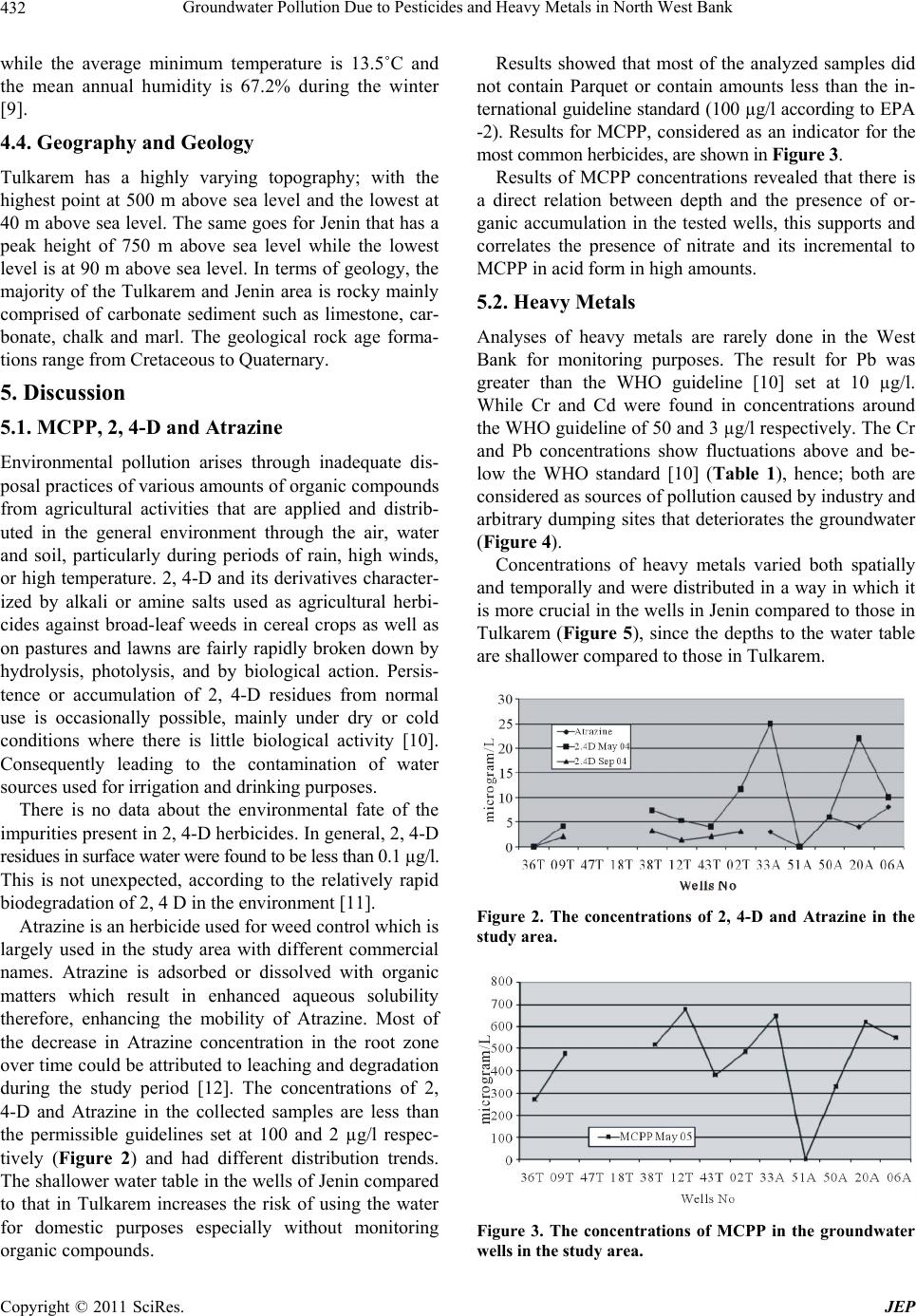
Groundwater Pollution Due to Pesticides and Heavy Metals in North West Bank
432
while the average minimum temperature is 13.5˚C and
the mean annual humidity is 67.2% during the winter
[9].
4.4. Geography and Geology
Tulkarem has a highly varying topography; with the
highest point at 500 m above sea level and the lowest at
40 m above sea level. The same goes for Jenin that has a
peak height of 750 m above sea level while the lowest
level is at 90 m above sea level. In terms of geology, the
majority of the Tulkarem and Jenin area is rocky mainly
comprised of carbonate sediment such as limestone, car-
bonate, chalk and marl. The geological rock age forma-
tions range from Cretaceous to Quaternary.
5. Discussion
5.1. MCPP, 2, 4-D and Atrazine
Environmental pollution arises through inadequate dis-
posal practices of various amounts of organic compounds
from agricultural activities that are applied and distrib-
uted in the general environment through the air, water
and soil, particularly during periods of rain, high winds,
or high temperature. 2, 4-D and its derivatives character-
ized by alkali or amine salts used as agricultural herbi-
cides against broad-leaf weeds in cereal crops as well as
on pastures and lawns are fairly rapidly broken down by
hydrolysis, photolysis, and by biological action. Persis-
tence or accumulation of 2, 4-D residues from normal
use is occasionally possible, mainly under dry or cold
conditions where there is little biological activity [10].
Consequently leading to the contamination of water
sources used for irrigation and drinking purposes.
There is no data about the environmental fate of the
impurities present in 2, 4-D herbicides. In general, 2, 4-D
residues in surface water were found to be less than 0.1 µg/l.
This is not unexpected, according to the relatively rapid
biodegradation of 2, 4 D in the environment [11].
Atrazine is an herbicide used for weed control which is
largely used in the study area with different commercial
names. Atrazine is adsorbed or dissolved with organic
matters which result in enhanced aqueous solubility
therefore, enhancing the mobility of Atrazine. Most of
the decrease in Atrazine concentration in the root zone
over time could be attributed to leaching and degradation
during the study period [12]. The concentrations of 2,
4-D and Atrazine in the collected samples are less than
the permissible guidelines set at 100 and 2 µg/l respec-
tively (Figure 2) and had different distribution trends.
The shallower water table in the wells of Jenin compared
to that in Tulkarem increases the risk of using the water
for domestic purposes especially without monitoring
organic compounds.
Results showed that most of the analyzed samples did
not contain Parquet or contain amounts less than the in-
ter national guideline standard (100 µg/l acco rding to EPA
-2). Results for MCPP, considered as an indicator for the
most common herbici des, are shown i n Figure 3.
Results of MCPP concentrations revealed that there is
a direct relation between depth and the presence of or-
ganic accumulation in the tested wells, this supports and
correlates the presence of nitrate and its incremental to
MCPP in acid form in high amounts.
5.2. Heavy Metals
Analyses of heavy metals are rarely done in the West
Bank for monitoring purposes. The result for Pb was
greater than the WHO guideline [10] set at 10 µg/l.
While Cr and Cd were found in concentrations around
the WHO guideline of 50 and 3 µg/l r espectively. The Cr
and Pb concentrations show fluctuations above and be-
low the WHO standard [10] (Table 1), hence; both are
considered as sources of pollution caused by industry and
arbitrary dumping sites that deteriorates the groundwater
(Figure 4).
Concentrations of heavy metals varied both spatially
and temporally and were distributed in a way in which it
is more crucial in the wells in Jenin compared to those in
Tulkarem (Figure 5), since the depths to the water table
are shallower compared to those in Tulkarem.
Figure 2. The concentrations of 2, 4-D and Atrazine in the
study area.
Figure 3. The concentrations of MCPP in the groundwater
wells in the study are a .
Copyright © 2011 SciRes. JEP